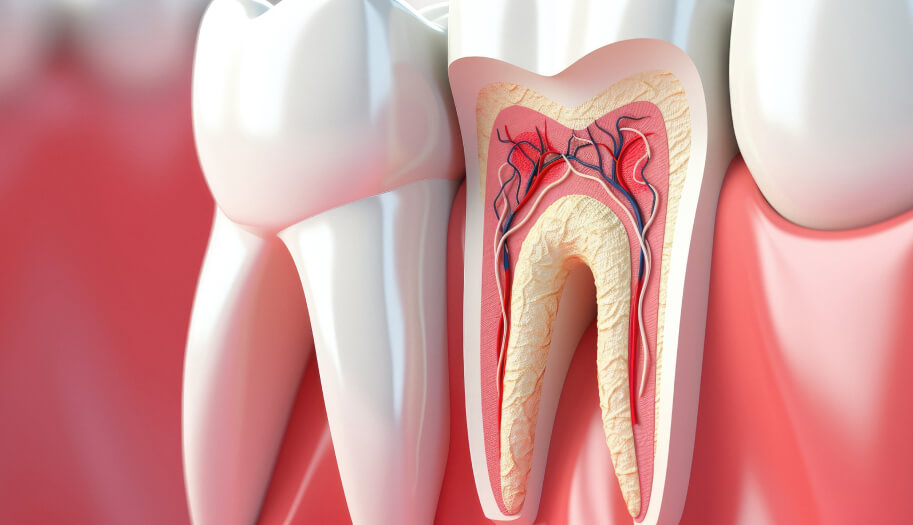Root canal treatments are often cloaked in myths and misconceptions, making it challenging for many to recognize when they might actually need one. Beyond the common fears and stories, understanding the real signs that necessitate a root canal can significantly enhance your oral health outcomes.
This article aims to demystify the symptoms and signs that could indicate a root canal is necessary, providing you with the knowledge to act swiftly and decisively. By identifying these cues early, you can address potential dental issues before they escalate into more serious conditions, ensuring that your smile remains both healthy and vibrant.
Recognizing Root Canal Symptoms
What is a Root Canal?
A root canal is a dental procedure aimed at treating infection at the center of a tooth (the root canal system). It’s not just a procedure but a last resort to save the tooth that might otherwise need to be removed. The treatment involves removing the bacteria-infected pulp, cleaning, and filling to prevent any further infection.
Common Symptoms and Signs
Understanding the symptoms of a root canal is crucial to seeking timely treatment and preventing further complications. Here are some of the most commonly reported symptoms:
- Severe Pain: One of the most unmistakable signs is a severe pain that comes on suddenly and may worsen in response to biting down or applying pressure to the tooth.
- Prolonged Sensitivity: A prolonged sensitivity to hot or cold temperatures that lingers long after the stimulus has been removed can also be a telltale sign.
- Tooth Discoloration: An infection in the pulp can cause significant discoloration or darkening of the affected tooth due to the breakdown of internal tissues.
- Swollen Gums: Swelling in the gums near the affected tooth often accompanies an infection. This may also include tenderness or a recurring or persistent gum boil.
Diagnosing the Need for a Root Canal
Being vigilant about the early signs can lead to more successful outcomes with a root canal treatment. Here’s what to watch for:
- Early Warning Signs: Minor discomfort in response to cold or hot foods and slight pain when chewing can be early indicators.
- When to See a Dentist: Any persistent symptoms should prompt a visit to the dentist. The sooner an accurate diagnosis is made, the better the chances of saving the tooth with minimal complications.
Recognizing these symptoms early and consulting with a dental professional can make a significant difference in the outcome of a root canal treatment and the overall health of your teeth. Being informed is your first line of defense against escalating dental issues.
Diagnosing the Need for a Root Canal
Early Warning Signs
Recognizing the need for a root canal at an early stage can greatly improve the outcome and potentially simplify the treatment process. Early signs may be subtle and can include:
- Minor Pain: Initial discomfort may be mild and intermittent, but it is important not to ignore it, as it may indicate the beginning stages of root infection.
- Sensitivity to Sweet, Hot, or Cold Foods: If a tooth begins reacting sharply to hot, cold, or sweet foods and the sensitivity lingers, this could be a sign of nerve damage or decay reaching the pulp.
- Discomfort with Chewing or Pressure: A sense of pain or discomfort when biting down or applying pressure might suggest that the tooth’s root is compromised.
When to See a Dentist
Prompt consultation with a dentist is crucial when symptoms suggest a potential root canal. If symptoms such as pain, sensitivity, or discomfort do not resolve on their own within a reasonable amount of time or progressively worsen, it’s imperative to schedule a dental visit. Additionally, escalating pain or discomfort that becomes hard to manage with over-the-counter pain relievers clearly indicates a need to see a dentist.
Diagnostic Procedures
To confirm whether a root canal is necessary, dentists employ several diagnostic tools and procedures:
- Physical Examination: The dentist will begin with a thorough examination of the affected tooth and surrounding gums to check for signs of infection or abscess.
- Percussion and Palpation Tests: Tapping on the tooth and pressing on the gums can help identify the affected area by eliciting responses to sensitivity and pain.
- X-rays: Dental X-rays are critical as they show the extent of damage to the tooth’s pulp and can reveal deep decay, cracks, or other problems invisible to the naked eye.
- Pulp Vitality Tests: These tests help determine the health of the pulp. Tools that measure response to temperature or electrical conductivity can indicate whether the tooth’s pulp is alive, which will influence treatment options.
By combining patient-reported symptoms with professional diagnostic techniques, dentists can accurately determine the need for a root canal treatment, ensuring that each decision towards dental health is well-informed and precisely targeted.
Understanding the Causes
Understanding the causes behind the need for a root canal is crucial for both preventing and treating root canal infections effectively. The primary reason for this treatment is an infection deep within the tooth. The pulp inside the tooth can become infected due to several factors including deep decay, repeated dental procedures on the same tooth, or a crack or chip in the tooth. Each of these can allow bacteria to penetrate through the enamel and dentin layers into the pulp, setting the stage for infection.
Another common cause is trauma to the tooth, which may not immediately result in a crack but can damage the pulp or nerve of the tooth. This trauma may cause the pulp to die, becoming a breeding ground for bacteria which can lead to infection and abscess without overtly visible cracks or chips. Furthermore, gum disease can also contribute to the conditions necessary for a root canal. Infections in the gums can reach the roots of the teeth and potentially affect the pulp.
Preventative measures include maintaining good oral hygiene to prevent decay and gum disease, using protective gear during sports to prevent trauma, and seeking timely treatment for dental injuries or discomfort. Regular dental check-ups are essential as they allow for early detection and treatment of problems that could escalate to require a root canal. Understanding these causes helps patients and dental professionals take proactive steps to maintain oral health and prevent the conditions that lead to more severe interventions like root canal therapy.
Conclusion
Recognizing and addressing the symptoms of a potential root canal as early as possible is crucial for maintaining your dental health and avoiding more serious complications. Understanding the signs, from severe pain to prolonged sensitivity, and knowing when to seek professional advice are key steps in managing your oral health proactively. At Greenlee Dental, we are dedicated to providing you with comprehensive care and the latest treatment options to ensure your dental needs are met with the highest standards of excellence.
If you’re experiencing any symptoms that might indicate a root canal, or if you have concerns about your dental health, don’t hesitate to reach out. Our experienced team, led by Dr. Kimberly Greenlee, is here to offer personalized care in a welcoming environment designed to alleviate any dental anxiety.


